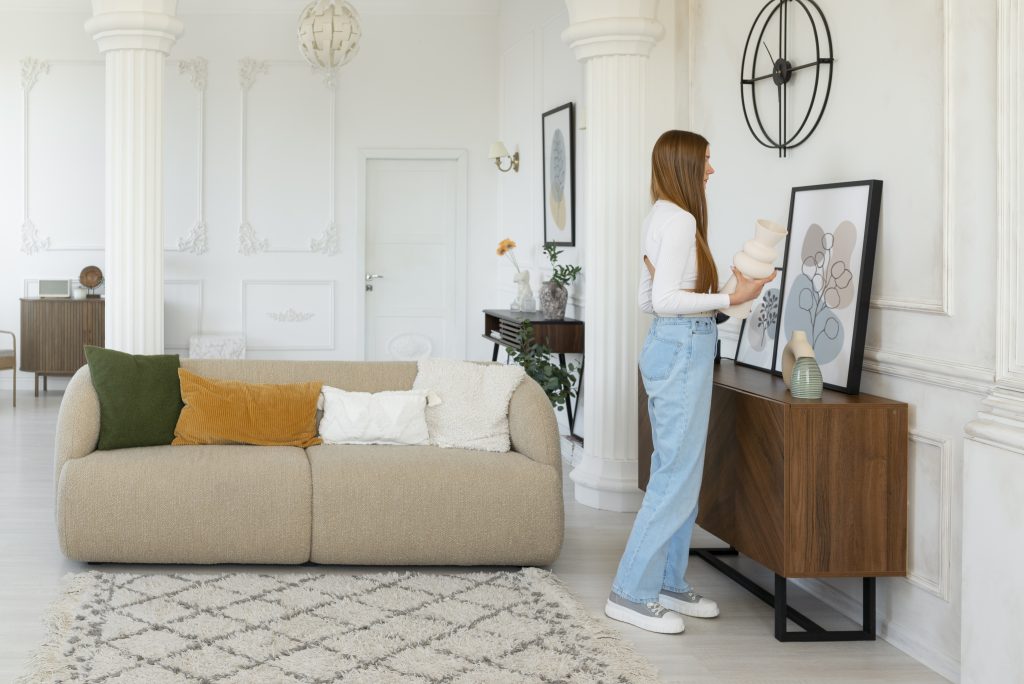How to Design a Minimalist Home That Maximizes Space
Jessica White August 12, 2025
In today’s fast-paced world, a minimalist lifestyle is more than just an aesthetic choice—it’s a way of creating a peaceful, organized environment that allows for mental clarity. One of the key aspects of minimalist design is maximizing space, making the most of every inch in a home. Whether you’re living in a small apartment or a spacious house, designing a minimalist home that maximizes space is achievable and highly beneficial.
In this article, we will explore the essential principles and actionable steps that will help you design a minimalist home that feels spacious, functional, and beautiful. From decluttering to smart furniture choices, let’s dive into the art of maximizing space while maintaining the minimalist aesthetic.

1. Declutter and Simplify
The first step to creating a minimalist home is decluttering. A cluttered environment can make even the largest spaces feel cramped and chaotic. Start by removing unnecessary items from every room. Consider what you truly need and what serves a functional or emotional purpose in your life. If an item doesn’t add value, it should be donated, sold, or discarded.
Minimalism is about keeping only the essentials. Begin by assessing your current furnishings, decor, and possessions. Make a list of what is truly necessary and let go of excess. When decluttering, use the “one in, one out” rule: if you bring something new into your home, make sure something else goes out. This simple approach helps prevent the accumulation of unnecessary items.
2. Maximize Natural Light
Natural light is a powerful tool in creating the illusion of space. A well-lit home feels airy and open, which is essential when trying to maximize space. To make the most of natural light, keep windows clear of heavy curtains or blinds. Opt for sheer window treatments or no window coverings at all if privacy allows.
If you have a small space, consider installing mirrors across from windows to reflect light and create the appearance of a larger area. Light-colored walls and floors can further enhance the brightness of the space. Neutral tones like white, soft grays, and light beiges can make a room feel more expansive.
3. Choose Furniture Wisely
In a minimalist design, furniture is not just for function—it’s an integral part of the room’s aesthetic. Choose furniture that is sleek, simple, and multi-functional. Look for pieces that serve more than one purpose. For example, opt for a sofa bed or a dining table that doubles as a workspace. Furniture that is raised off the floor also creates a sense of openness by allowing more visible floor space.
When selecting furniture for small rooms, avoid bulky items. Instead, choose pieces with clean lines and minimal details. Avoid heavy, ornate furniture that can overpower a room and make it feel crowded. Light, streamlined furniture is the key to achieving the minimalist aesthetic while maintaining functionality.
4. Use Smart Storage Solutions
One of the challenges of minimalist living is finding a way to store belongings without compromising the aesthetic of the space. The key is to find clever storage solutions that allow you to keep your home organized and clutter-free without sacrificing style.
Built-in storage is a fantastic option for maximizing space. Custom cabinetry, under-bed storage, and wall-mounted shelves can help you keep essential items neatly tucked away while still maintaining an open, airy feel. Consider investing in hidden storage, such as ottomans with compartments or a coffee table that doubles as a storage chest.
For small spaces, vertical storage is essential. Make use of wall space by adding shelves or tall storage units that can hold books, decor, or everyday essentials. This not only keeps items off the floor but also draws the eye upward, making the space feel taller.
5. Opt for Minimalist Decor
In a minimalist home, less is more when it comes to decor. Choose a few carefully selected art pieces or decorative items that complement the overall aesthetic of the room. Don’t overwhelm the space with too many knick-knacks or unnecessary ornaments. Instead, focus on quality over quantity.
For example, a single large piece of art can make a striking focal point in a living room without creating visual clutter. The same goes for plants—opt for a few large, statement plants rather than multiple smaller ones scattered around the room. This creates a clean, intentional look that aligns with the minimalist ethos.
6. Embrace Neutral and Monochromatic Palettes
One of the hallmarks of minimalist design is a neutral or monochromatic color palette. By using shades of white, beige, gray, and black, you can create a serene and cohesive atmosphere that doesn’t feel overwhelming. These colors reflect light and make spaces appear larger and more open.
However, that doesn’t mean you have to sacrifice warmth or personality. Accent colors in the form of textiles, such as throw pillows, blankets, and rugs, can add subtle contrast without detracting from the overall minimalist vibe. The key is to keep the color scheme simple and focused, while still introducing elements that bring warmth and character to the space.
7. Create Defined Zones in Open Spaces
In open-plan homes, it’s important to define specific zones for different activities. This can be done without erecting walls or partitions, which would defeat the purpose of maximizing space. Instead, use rugs, furniture arrangements, and lighting to demarcate different areas.
For example, in a combined living and dining room, a rug can visually separate the two spaces, helping each area feel distinct while still maintaining an open layout. Similarly, a sofa placed with its back to the dining area creates a natural division between the living and dining zones. Lighting also plays a key role—use pendant lights above the dining table or task lighting for a reading nook to highlight the different areas.
8. Go for High-Quality, Functional Materials
Minimalism is all about valuing quality over quantity. Opt for high-quality materials in your home, such as hardwood floors, stone countertops, and solid wood furniture. These materials not only look beautiful but also stand the test of time, making them a smart investment for any minimalist space.
In addition to their durability, quality materials often have a timeless appeal that complements the minimalist aesthetic. Materials like marble, glass, and metal are often used in minimalist design for their clean, simple lines and neutral tones. Incorporating these elements into your home ensures that the space will continue to look sleek and modern for years to come.
Conclusion
Designing a minimalist home that maximizes space involves more than just removing clutter. It’s about making intentional decisions that prioritize functionality, simplicity, and timeless beauty. By incorporating natural light, choosing the right furniture, utilizing smart storage, and embracing a neutral color palette, you can create a space that feels open, calm, and organized.
Whether you live in a small apartment or a larger home, these minimalist principles can be adapted to suit your unique space. Embrace the minimalist lifestyle, and enjoy a home that maximizes both space and serenity.
References
- McCoy, M. (2019). The Minimalist Home: A Room-by-Room Guide to a Decluttered, Refocused Life. Tyndale Momentum. Available at: https://www.tyndale.com (Accessed: 12 August 2025).
- Smith, A. (2021). Minimalism in Interior Design: A Comprehensive Guide. Design Press. Available at: https://www.designpress.com (Accessed: 12 August 2025).
- Johnson, L. (2020). “How to Maximize Space in Small Homes”. House & Home Magazine. Available at: https://www.houseandhome.com (Accessed: 12 August 2025).







